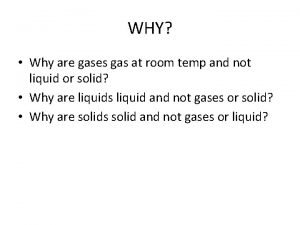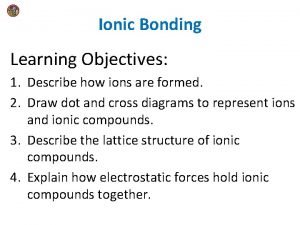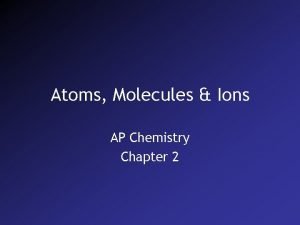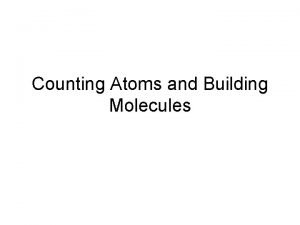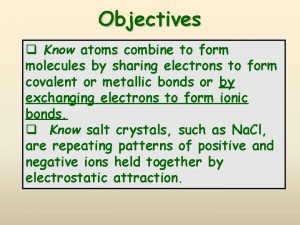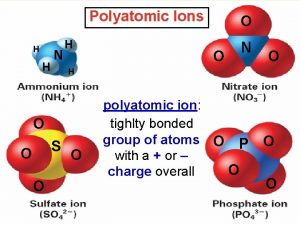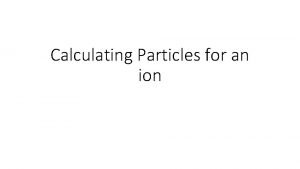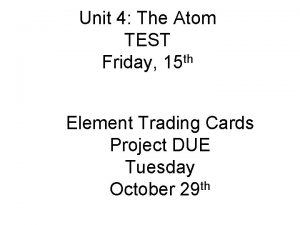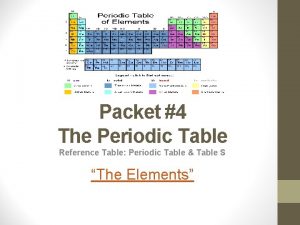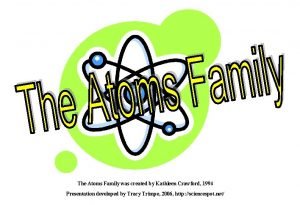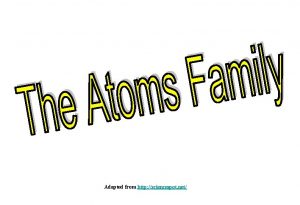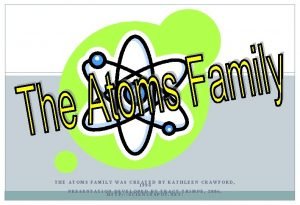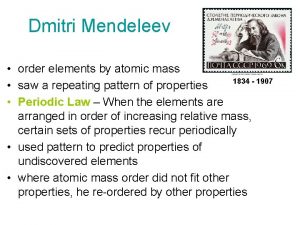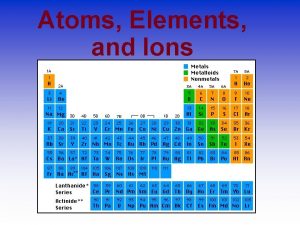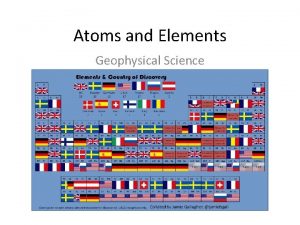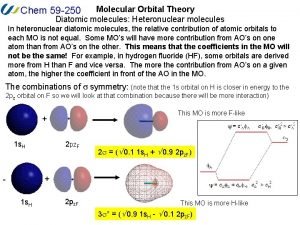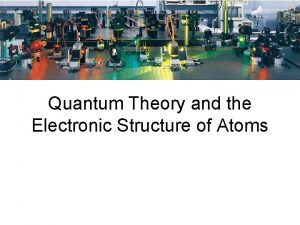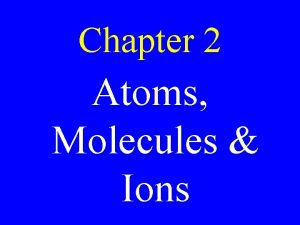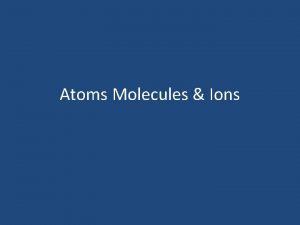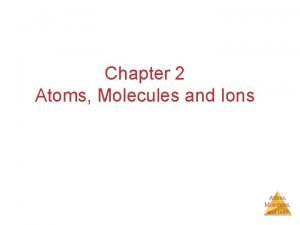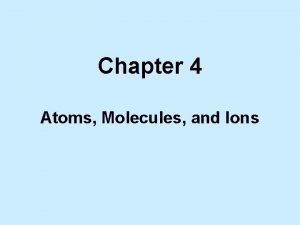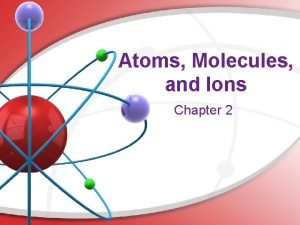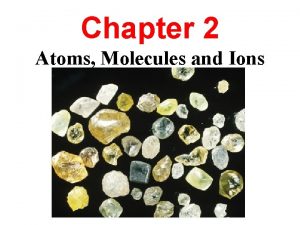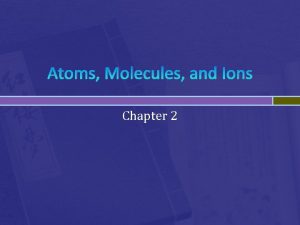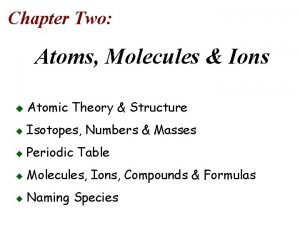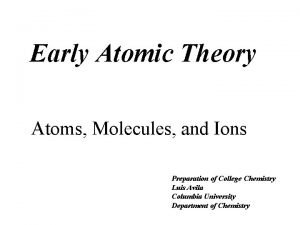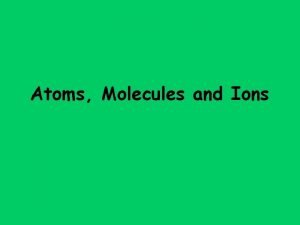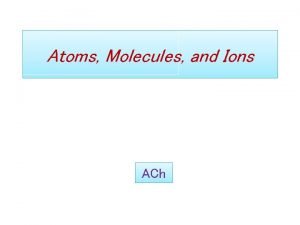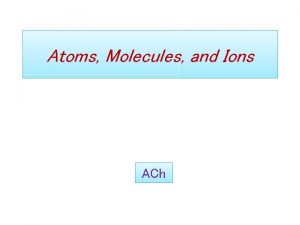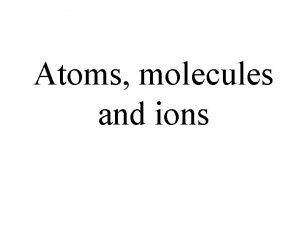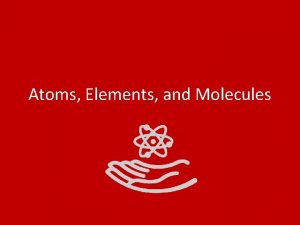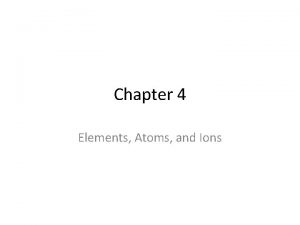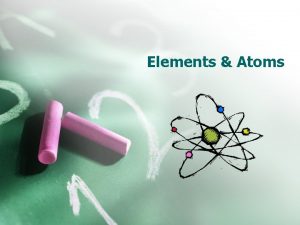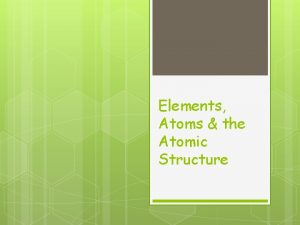Chapter 2 Atoms Molecules Ions Atomic Theory Elements












































- Slides: 44

Chapter 2 • Atoms, Molecules, & Ions

Atomic Theory • Elements composed of atoms • Atoms can’t be changed • Compounds of multiple atoms • John Dalton

Conservation of Mass • In ordinary chemical reactions, matter can be neither created nor destroyed

Constant Composition • Compounds contain elements that are always in the same proportions

Multiple Proportions • The elements making up a compound will form whole number ratios

Atom • The smallest particle an element can be broken down into and still maintain the identity of the element

Nuclear Atom • Proved by Rutherford & Bohr in the famous gold foil experiments

Atomic Composition • Proton: in the nucleus • Neutron: in the nucleus • Electron: outside the nucleus

Proton • In Nucleus • +1 relative charge • About 1 amu in mass

Neutron • In nucleus • Neutral, zero charge • Mass is about 1 amu

Electron • Outside the nucleus • -1 in relative charge • Negligible mass about 1/2000 amu

Electron Charge • Determined by Robert Milliken in the famous oil droplet experiment

Atomic Number • The number of protons in an element • Z number

Mass Number • The number of protons and neutrons in an atom • A - number

Nuclear Symbol A 4 X Z General Formula 2 He Specific Example

Isotopes • Atoms that contain the same number of protons, but different number of neutrons • Z constant, A variable

Isotopes are useful! • C 14 - dating • Isotopic-tracing

Shorthand for isotopes Instead of full notation: 14 C Write: C-14 6 So, only the Z number (protons + neutrons)

Atomic Mass • All elements have >1 isotope. • The percentage of one isotope is its relative abundance. • Atomic mass = (isotopic mass # 1 multiplied by % of isotope #1) + (isotopic mass # 2 multiplied by % of isotope # 2) + etc… • Usually about 3 or 4 isotopes for a given element is maximum.

Periodic Table • Graphic hierarchy of all the elements. • The order is used to predict size, charge, electronic structure, & reactivity of elements

Periods • Rows which indicate energy level or shell or size of the atoms

Groups or Families • Columns which indicate the number of electrons in the outermost energy level determining charge & reactivity

Metals • Left three quarters of the chart • Lose electrons • Become positive

Nonmetals • Upper right portion • Gain, lose, or share electrons when they react

Metalloids • Along the stair-stepped line from B to At • Share properties of metals & nonmetals

Radioactivity • The spontaneous breakdown of an unstable nucleus

Radioactive Decay • Alpha radiation • Beta radiation • Gamma radiation

Alpha Particle • Helium nucleus • 2 protons & two neutrons • mass = 4 & charge = +2 • Low penetrating power

Beta Particle • High speed electron • Mass = 0 & charge = -1 • Medium penetrating power

Gamma Rays • High energy electromagnetic wave • No mass or charge • Very high penetrating power

Compound • A group of atoms that are chemically combined

Molecule • A compound that can exist by itself

Diatomic Molecule • Two atoms of the same element that are chemically combined • Cl 2, F 2, O 2

Ion • Charged Particle -1 • Cl

Polyatomic Ion • A group of atoms chemically combined that together has a charge -2 • SO 4

Binary Compound • A compound made up of two elements in any ratio • Na. Cl • Mg 3 P 2

Chemical Formula • A formula that shows the number and kinds of atoms in a compound • Ca. CO 3

Molecular Formula • A formula that shows the number and kinds of atoms in a molecule • C 6 H 12 O 6

Atomic Structure • List & describe three subatomic particles

Atomic Structure • Fill in the Chart: • Isotope protons neutrons electrons • U-235 • 56 80 • 14 13

Calculate the atomic mass of the element made up of the following isotopes: 99. 50 % H-1 0. 30 % H-2 0. 20 % H-3

Calculate Pt’s atomic mass : 5. 0 % Pu-242 5. 0 % Pu-243 80. 0 % Pu-244 10. 0 % Pu-245

Determine the number of atoms in each compound • C 6 H 12 O 6 Na. NO 3 • H 3 PO 4 Al 2(SO 4)3

List & describe each of the three types of radiation
 Chapter 2 atoms molecules and ions
Chapter 2 atoms molecules and ions Atoms molecules and ions
Atoms molecules and ions Atoms molecules and ions
Atoms molecules and ions Atoms molecules and ions
Atoms molecules and ions Atoms molecules and ions
Atoms molecules and ions Atoms ions and molecules
Atoms ions and molecules Atoms ions and molecules
Atoms ions and molecules States that atoms ions and molecules must collide to react
States that atoms ions and molecules must collide to react Mixture of compounds diagram
Mixture of compounds diagram Positive ions and negative ions table
Positive ions and negative ions table Interacting molecules or ions
Interacting molecules or ions Organic molecules vs inorganic molecules
Organic molecules vs inorganic molecules How does a positive ion form
How does a positive ion form Atoms or ions are considered isoelectronic if
Atoms or ions are considered isoelectronic if Relationship between atoms and molecules
Relationship between atoms and molecules How can you count atoms and molecules
How can you count atoms and molecules Why do atoms combine to form molecules
Why do atoms combine to form molecules Compared to atoms of metals, atoms of nonmetals generally
Compared to atoms of metals, atoms of nonmetals generally Polyatomic ion chart
Polyatomic ion chart Ions atomic number
Ions atomic number Hydrosulfuric acid
Hydrosulfuric acid The atoms family atomic math challenge answer key
The atoms family atomic math challenge answer key Which atoms has the largest atomic radius
Which atoms has the largest atomic radius The atoms family atomic math challenge
The atoms family atomic math challenge Matterville
Matterville The atom family atomic math challenge
The atom family atomic math challenge The atoms family atomic math challenge
The atoms family atomic math challenge Chapter 6 section 1 atoms elements and compounds
Chapter 6 section 1 atoms elements and compounds Chapter 6 section 1 atoms elements and compounds
Chapter 6 section 1 atoms elements and compounds Is atomic mass and relative atomic mass the same
Is atomic mass and relative atomic mass the same Periodic trends
Periodic trends Increasing ionic radius
Increasing ionic radius How to calculate abundance of isotopes
How to calculate abundance of isotopes Differentiate between atomic number and mass number
Differentiate between atomic number and mass number Atomic number vs atomic radius
Atomic number vs atomic radius M in periodic table
M in periodic table Which elements exist as diatomic molecules
Which elements exist as diatomic molecules Expanded octet
Expanded octet Www.chem.purdue/gchelp/atoms/elements.html
Www.chem.purdue/gchelp/atoms/elements.html Section 1 atoms elements and compounds
Section 1 atoms elements and compounds Heteronuclear diatomic molecules molecular orbital diagram
Heteronuclear diatomic molecules molecular orbital diagram E
E Quantum mechanical model
Quantum mechanical model Electrons in atoms section 2 quantum theory and the atom
Electrons in atoms section 2 quantum theory and the atom Quantum theory and the electronic structure of atoms
Quantum theory and the electronic structure of atoms










